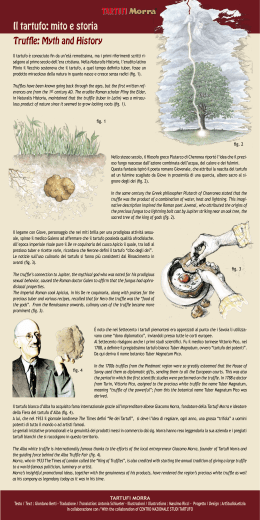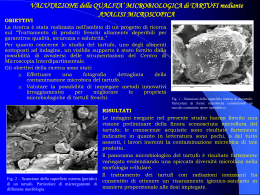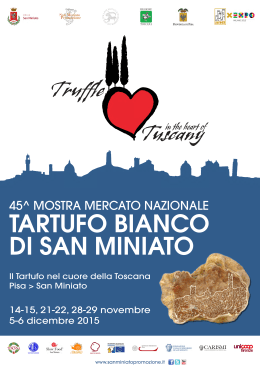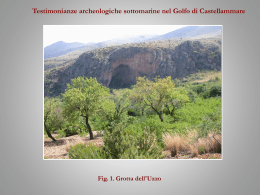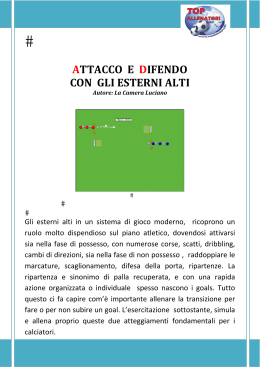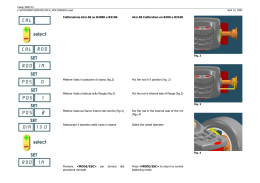h Il tartufo: come e dove nasce? Truffle: How and Where it Grows Il tartufo è un tipo particolare di fungo tuberoso, definito ipogeo in quanto nasce e vive la sua intera esistenza sottoterra. I tartufi non crescono dappertutto, ma solo tra le radici di alcune piante arboree con le quali vivono in simbiosi: per esempio querce, pioppi, noccioli, salici e tigli (fig. 1). In pratica, il tartufo estrae zuccheri dalle radici della pianta; in cambio cede acqua, potassio, sodio e altri sali minerali utili alla pianta stessa (fig. 2). The truffle is a particular type of tuberous fungus. It is hypogeous, meaning it spends its entire lifecycle underground. Truffles do not grow just anywhere, but only at the roots of the trees with which they live in symbiosis, such as oaks, large-leaved limes, Turkey oaks, hornbeams, black poplars, willows, and hazels (fig. 1). As it grows, a truffle extracts sugars from the tree’s roots but in exchange releases water, potassium, sodium and other mineral salts which are useful to the tree (fig. 2). fig. 1 La nascita del tartufo avviene tramite le spore, cioè i minuscoli semi contenuti in un vecchio tartufo, che attecchiscono sul luogo oppure sono trasportate involontariamente da alcuni animali che si cibano di tartufi, come lumache, ricci e scoiattoli. Le spore (fig. 3) si posano sulla radice della pianta e, “abbracciandosi” ad essa, producono le micorrize (fig. 4). fig. 2 Nocciolo Corylus Avellana Querciola Quercus Pubescens Salicione Salix Caprea Lo scambio di sostanze minerali tra micorrize e radici permette la sviluppo delle ife, filamenti sottilissimi che, intrecciandosi fra loro come un ricamo, vanno a formare il micelio. Ad un certo punto, dal micelio comincia a crescere lo sporocarpo, ossia il nucleo iniziale del tartufo (fig. 5). Ma affinché ciò avvenga è necessario che vi siano un’idonea composizione del terreno e un’adeguata umidità. The exchange of minerals between the mycorrhizae and the tree roots allows the development of tiny filaments called hyphae which weave themselves together, eventually forming the mycelium. At a certain point the mycelium starts producing the sporocarp which is the initial nucleus of the truffle (fig. 5). But for all of this to happen there must be ideal soil conditions and adequate moisture due to alternating rainfall and periods of sunshine. fig. 5 fig. 6 A truffle comes into being through the spores, which are the tiny seeds of an old truffle. These either remain where a previous truffle grew, or they are involuntarily transported by animals which live in the undergrowth and feed on truffles such as snails, hedgehogs and squirrels. The spores (fig. 3) come into contact with the roots of the tree and “embrace” them, producing the mycorrhizae (fig. 4). fig. 3 fig. 4 Il tempo di maturazione può variare da 5 a 8 settimane, o anche di più, secondo la specie del tartufo, il tipo di terreno e il clima. I tartufi (fig. 6) sono variabili per forma e dimensioni, per l’aspetto della buccia e per sapore. Alcuni diventano grandi al massimo come nocciole, altri come mele, ma alcuni esemplari eccezionali possono superare il chilogrammo. Rispetto ai funghi, i tartufi hanno un profumo più persistente, per via delle spore, fonte dell’odore, che si propagano sottoterra senza disperdersi nell’aria come quelle dei funghi epogei. The growth period can vary between 5 to 8 weeks or more, depending on the species of truffle, the type of terrain and the climate. Truffles (fig. 6) vary greatly in shape and size, exterior appearance and flavor. Some are the size of hazelnuts, others are as big as apples, and some exceptional specimens become huge, weighing more than 1 kilogram. Truffles have an odor which is more persistent than that of mushrooms because the spores, which are the source of the odor, are propagated underground and are not dispersed in the air as happens with mushrooms, which grow above ground. Le colline che circondano Alba e le Langhe, in generale sono luoghi particolarmente favorevoli alla crescita dei tartufi in ogni periodo dell’anno: tra i più conosciuti, i pregiatissimi tartufi bianchi (Tuber Magnatum Pico), i tartufi estivi (Tuber Aestivum Vitt.) e i tartufi neri invernali (Tuber Melanosporum Vitt.). Quando sono maturi, i tartufi bianchi hanno un profumo inconfondibile in cui si percepiscono vari aromi: aglio, fieno, terra bagnata, miele, funghi e spezie. The hills surrounding Alba and the Langhe are in general particularly favorable for the growth of truffles year round. Among the best known are the highly sought after white truffles (Tuber Magnatum Pico), summer truffles (Tuber Aestivum Vitt.) and black winter truffles (Tuber Melanosporum Vitt.). When they are ripe, truffles have an unmistakable odor with aromas recalling garlic, hay, damp earth, honey, mushrooms and spices. TARTUFI MORRA Testo / Text : Giordano Berti - Traduzione / Translation: Antonia Schlueter - Illustrazioni / Illustrations : Massimo Ricci - Progetto / Design : ArtStudioLetizia In collaborazione con / With the collaboration of CENTRO NAZIONALE STUDI TARTUFO
Scarica
